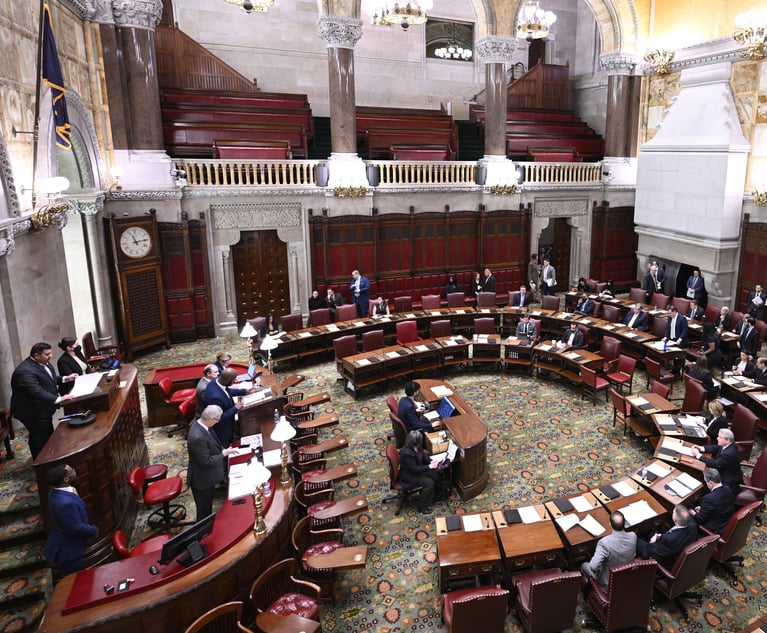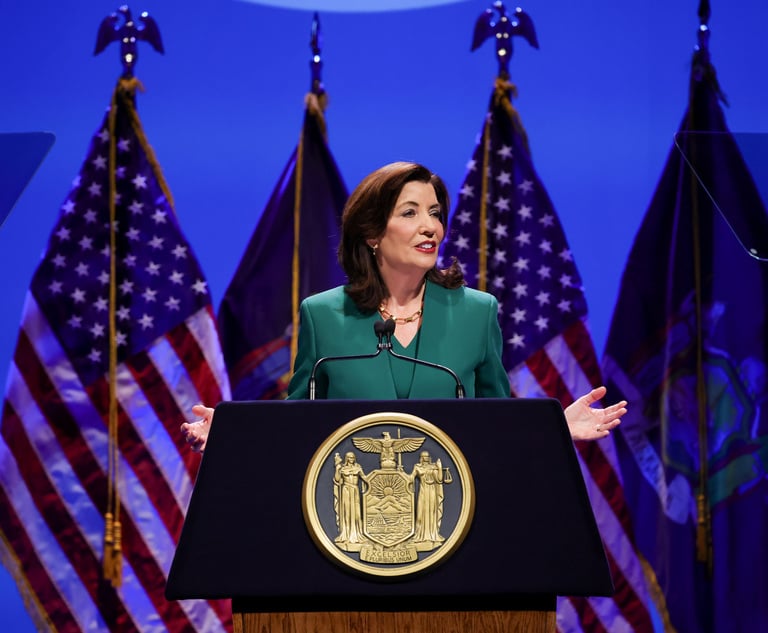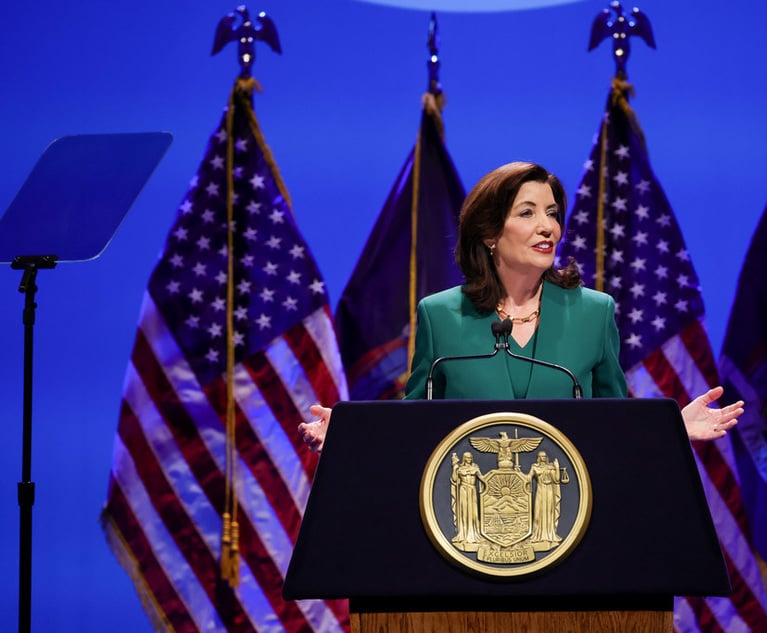Rent Stabilization Should Remain for Apartments Built With Tax Abatements, NY High Court Rules
The decision by the Court of Appeals was nearly unanimous, save for one dissenting opinion penned by Chief Judge Janet DiFiore, who wrote that the landlords involved in the litigation should have been allowed to deregulate the units.
June 25, 2019 at 02:17 PM
6 minute read
 Photo: Andriy Blokhin/Shutterstock.com
Photo: Andriy Blokhin/Shutterstock.com
A coalition of tenants in New York City were handed a win Tuesday by the New York Court of Appeals when it ruled that a section of state law that previously ended rent stabilization at a certain rent or income threshold didn't apply to their apartments.
The decision by the Court of Appeals was nearly unanimous, save for one dissenting opinion penned by Chief Judge Janet DiFiore, who wrote that the landlords involved in the litigation should have been allowed to deregulate the units.
The decision is the result of two separate lawsuits from tenants of three residential buildings in lower Manhattan who were seeking reimbursement of alleged rent overcharges after they claimed their apartments were improperly removed from rent stabilization.
Those units were built under a program that traded tax abatements to developers for converting commercial space to residential use. The building owners had argued that the law creating that program, Real Property Tax Law § 421-g, still allowed them to remove units from rent control that were priced above a certain threshold.
That practice is more commonly known as luxury decontrol. It was repealed in recent weeks by a law enacted by the state Legislature and Gov. Andrew Cuomo. But that development doesn't apply to the case since the claims date back several years.
Associate Judge Leslie Stein wrote in the court's decision that a reading of the statute's plain language supported their interpretation that the units could not be removed from rent stabilization, and that those built through 421-g were not included in a list of exceptions spelled out by the Legislature.
“Defendants' contention, adopted by the dissent, that the notwithstanding clause was intended to import into RPTL 421-g (6) the entire [Rent Stabilization Law], including those provisions that would remove the units from control, cannot be squared with the statutory language,” Stein wrote. “If the legislature intended to import the deregulation provisions of the RSL, it easily could have so stated.”
The tenants were represented by Robert Smith, a former associate judge of the Court of Appeals who's now a partner at Friedman Kaplan Seiler & Adelman in Manhattan.
“We're delighted at the outcome and we think the court did the right thing,” Smith said Tuesday.
Smith had argued before the court earlier this month much of the same point that Stein made in the court's decision—that the plain language of the statute supported the tenants' position that their units should not have been deregulated. A subdivision of that law appears to allow rent control for units created under the statute, he said.
That part of the law reads that “the rents of each dwelling unit in an eligible multiple dwelling shall be fully subject to control under such local law,” notwithstanding the provisions of any local law for the stabilization of rent.
There are some types of units created through state tax abatement programs, like 421-a, that are exempt from luxury vacancy decontrol. But those are spelled out in state law. The building owners had argued before the court earlier this month that, because the Legislature didn't include units built under 421-g in that list of exceptions, they should have been eligible for deregulation. Stein, and five of the court's other judges, weren't convinced.
“Invoking the canon of statutory construction that enumerated exceptions are generally considered exclusive, they contend that the legislature's decision not to add section 421-g to the list of exceptions to luxury deregulation in the RSL is dispositive,” Stein wrote. “We disagree.”
The building owners were represented by James McGuire, a partner at Holwell Shuster & Goldberg, and Magda Cruz, a partner at Belkin Burden Wenig & Goldman. McGuire was not immediately available for comment. Cruz said they were still reviewing the decision and declined to comment further.
DiFiore wrote in her dissent that she would have affirmed a ruling in the case last year by the Appellate Division, First Department, which rejected the tenants' claims in a unanimous decision.
“Based on a purported plain text analysis of language that makes no mention of luxury decontrol—the majority retroactively confers this heightened form of rent stabilization on buildings receiving RPTL 421-g tax benefits,” DiFiore wrote. “Because I agree with the unanimous decision of the Appellate Division that this approach misinterprets the statutory text, disregarding the broader regulatory scheme and legislative purpose of the relevant statutes, I respectfully dissent.”
She flipped the majority's point about exceptions to deregulation on its head, making the same argument as the building owners. Because the Legislature didn't explicitly say units built under 421-g were exempt from luxury decontrol, DiFiore wrote, they should have been eligible for deregulation.
“The fact that the Legislature considered it necessary to create a statutory exemption to luxury decontrol for section 421-a apartments demonstrates that it understood that, absent such exemption, the entirety of the RSL—including luxury decontrol—would apply to them,' DiFiore wrote. “Its decision not to include section 421-g buildings in the exemption should be given that effect.”
The decision doesn't mean that the tenants who brought the litigation will automatically be granted reimbursement for alleged overcharges of rent. Now that the Court of Appeals has decided the question of whether the units were subject to luxury decontrol, the case will now head back to the trial court for further proceedings.
Associate Judges Jenny Rivera, Eugene Fahey, Michael Garcia, Rowan Wilson and Paul Feinman concurred with Stein's opinion. DiFiore was the lone dissent.
READ MORE:
Court of Appeals Weighs Whether NY Tax Law Requires Rent Reimbursement for Tenants
NY Court of Appeals OKs Waiver by Tenant of Declaratory Judgment Action
NY Court of Appeals Allows Ineffective Counsel Hearing in Murder Case
NOT FOR REPRINT
© 2025 ALM Global, LLC, All Rights Reserved. Request academic re-use from www.copyright.com. All other uses, submit a request to [email protected]. For more information visit Asset & Logo Licensing.
You Might Like
View All
Relaxing Penalties on Discovery Noncompliance Allows Criminal Cases to Get Decided on Merit
5 minute read
Bipartisan Lawmakers to Hochul Urge Greater Student Loan Forgiveness for Public-Interest Lawyers

'Playing the Clock'?: Hochul Says NY's Discovery Loophole Is to Blame for Wide Dismissal of Criminal Cases

So Who Won? Congestion Pricing Ruling Leaves Both Sides Claiming Victory, Attorneys Seeking Clarification
4 minute readTrending Stories
- 1Lawyers: Meet Your New Partner
- 2What Will It Mean in California if New Federal Anti-SLAPP Legislation Passes?
- 3Longtime AOC Director Glenn Grant to Step Down, Assignment Judge to Take Over
- 4Elon Musk’s Tesla Pay Case Stokes Chatter Between Lawyers and Clients
- 5Courts Demonstrate Growing Willingness to Sanction Courtroom Misuse of AI
Who Got The Work
J. Brugh Lower of Gibbons has entered an appearance for industrial equipment supplier Devco Corporation in a pending trademark infringement lawsuit. The suit, accusing the defendant of selling knock-off Graco products, was filed Dec. 18 in New Jersey District Court by Rivkin Radler on behalf of Graco Inc. and Graco Minnesota. The case, assigned to U.S. District Judge Zahid N. Quraishi, is 3:24-cv-11294, Graco Inc. et al v. Devco Corporation.
Who Got The Work
Rebecca Maller-Stein and Kent A. Yalowitz of Arnold & Porter Kaye Scholer have entered their appearances for Hanaco Venture Capital and its executives, Lior Prosor and David Frankel, in a pending securities lawsuit. The action, filed on Dec. 24 in New York Southern District Court by Zell, Aron & Co. on behalf of Goldeneye Advisors, accuses the defendants of negligently and fraudulently managing the plaintiff's $1 million investment. The case, assigned to U.S. District Judge Vernon S. Broderick, is 1:24-cv-09918, Goldeneye Advisors, LLC v. Hanaco Venture Capital, Ltd. et al.
Who Got The Work
Attorneys from A&O Shearman has stepped in as defense counsel for Toronto-Dominion Bank and other defendants in a pending securities class action. The suit, filed Dec. 11 in New York Southern District Court by Bleichmar Fonti & Auld, accuses the defendants of concealing the bank's 'pervasive' deficiencies in regards to its compliance with the Bank Secrecy Act and the quality of its anti-money laundering controls. The case, assigned to U.S. District Judge Arun Subramanian, is 1:24-cv-09445, Gonzalez v. The Toronto-Dominion Bank et al.
Who Got The Work
Crown Castle International, a Pennsylvania company providing shared communications infrastructure, has turned to Luke D. Wolf of Gordon Rees Scully Mansukhani to fend off a pending breach-of-contract lawsuit. The court action, filed Nov. 25 in Michigan Eastern District Court by Hooper Hathaway PC on behalf of The Town Residences LLC, accuses Crown Castle of failing to transfer approximately $30,000 in utility payments from T-Mobile in breach of a roof-top lease and assignment agreement. The case, assigned to U.S. District Judge Susan K. Declercq, is 2:24-cv-13131, The Town Residences LLC v. T-Mobile US, Inc. et al.
Who Got The Work
Wilfred P. Coronato and Daniel M. Schwartz of McCarter & English have stepped in as defense counsel to Electrolux Home Products Inc. in a pending product liability lawsuit. The court action, filed Nov. 26 in New York Eastern District Court by Poulos Lopiccolo PC and Nagel Rice LLP on behalf of David Stern, alleges that the defendant's refrigerators’ drawers and shelving repeatedly break and fall apart within months after purchase. The case, assigned to U.S. District Judge Joan M. Azrack, is 2:24-cv-08204, Stern v. Electrolux Home Products, Inc.
Featured Firms
Law Offices of Gary Martin Hays & Associates, P.C.
(470) 294-1674
Law Offices of Mark E. Salomone
(857) 444-6468
Smith & Hassler
(713) 739-1250






